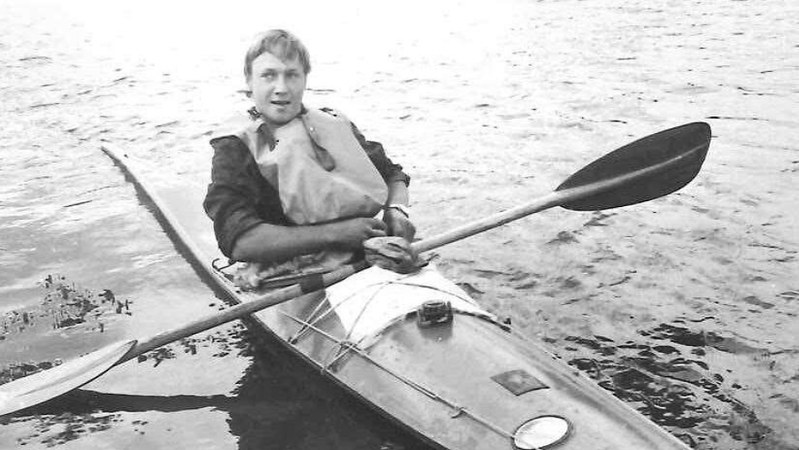
Photos: The Sea-Padders Tale
On the 3rd of May 1970 a relatively inexperienced 23 year old sea kayaker, Geoff Hunter, set off from Maidstone to paddle around Great Britain. His story has been put together into a book, The Sea-Paddlers Tale, by Geoff’s friend and renowned kayak author Bill Taylor, using Geoff’s logbook and Bill’s experience, to add insight to the exiting tale.
Two months after setting off, having paddled up the East coast of Scotland, through the Caledonian Canal, and back down the West coast, Geoff found himself five miles out to sea swimming for his life, having been separated from his kayak while crossing the Solway Firth.
Clinging to a buoy overnight, Geoff resolved to swim for the shore when morning came and the tide turned in his favour. It must have felt a long way from Maidstone and the banks of the Medway, where Geoff had first nervously tested his home-built kayak on the day of his departure in front of a crowd of well-wishers.
He had made the boat using an Inuit ‘Angmassalik’ design with the help of his school woodwork teacher Ken Littledyke, who was fundamental in getting many people into building and paddling their own kayaks and even in the creation of the Mirror sailing dingy that introduced thousand of people to building and sailing their own boats.
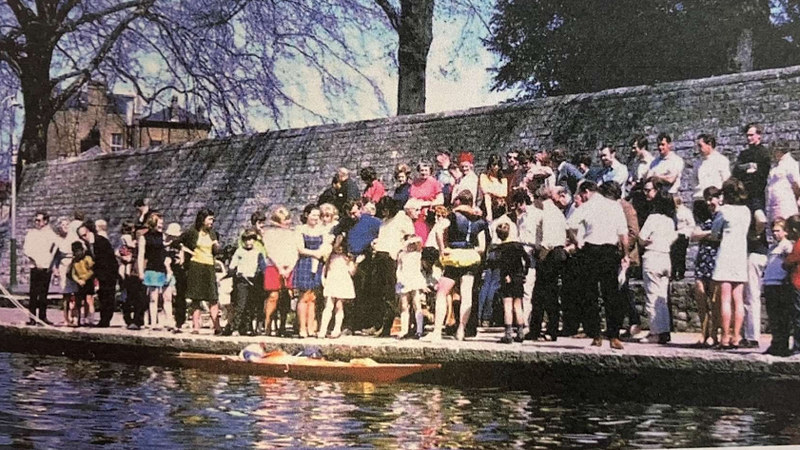
"The launching was a tense moment. Angmagssalik are not [designed to be] loaded to this extent and I prayed it would not sink. Would it or wouldn't it? Great! The kayak floated nicely and jumping into the cockpit, I reassured myself it would take my weight as well."
Geoff had spent the first day accompanied by members of Maidstone Canoe Club but by the end of the day his confidence was already ebbing as he reached Sheerness and snuck onto a private campsite.
"I had been a little downhearted prior to unpacking my kit, [having] to carry it bit by bit over to my campsite, but on opening the rear hatch of the kayak, total depression really set in. The 'watertight' hatches were not keeping the sea water at bay…."
With his kit waterlogged his mood was sinking as he lifted his kayak over the fence of a private campsite, "The boat took quite a crack as I bundled it over the top of a fence... My feelings at the time were that the kayak would be doing me a favour by breaking in half, thus giving me an excuse for abandoning this whole stupid project.”
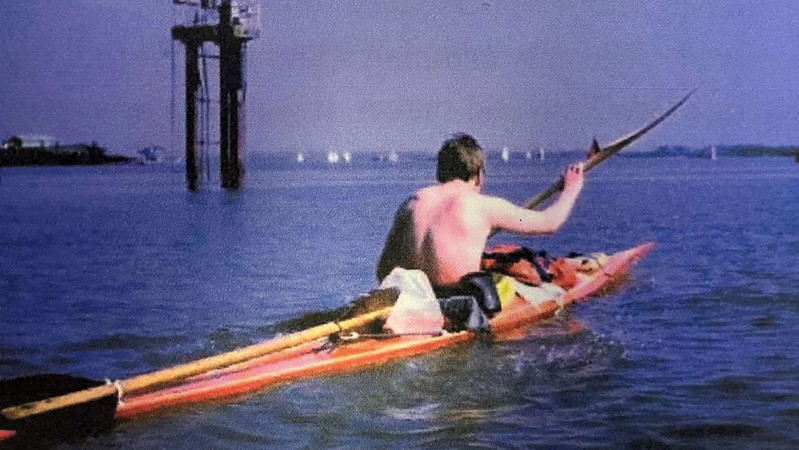
However an evening visit from his friends lifted his spirits, and after a few beers in Sheerness, Geoff resolved to carry on with the journey the next day. By the time he was heading up the East coast of Scotland, he was starting to show signs of a bit of overconfidence when, for a second time he paddled into a live firing range, this time by deciding to ignore the red flags of the army personnel.
"The choice was either to make the Army wait for ten minutes or sit on the beach and hang around for the rest of the afternoon. Selfishly I made the army wait and while the two little men jumped up and down... I accelerated past the flags... leaving the gunfire cracking out across the water behind me.”
A foolhardy decision perhaps, but the young Geoff then decided to take advice not to attempt the far north of Scotland, and curtailed his full circumnavigation by cutting through Loch Ness and the Caledonian Canal, meaning he’d have to settle for being the “first person to circumnavigate England and Wales” (and most of Scotland) by kayak.
The adventures continue in the book, often with the help of the coastguard and the public. Blagging beds for the night off strangers and at one point in a Benedictine monastery on the banks of Loch Ness. He also recalls the occasional drinking session with fishermen, yacht crews, and one night with Miss UK 1970.
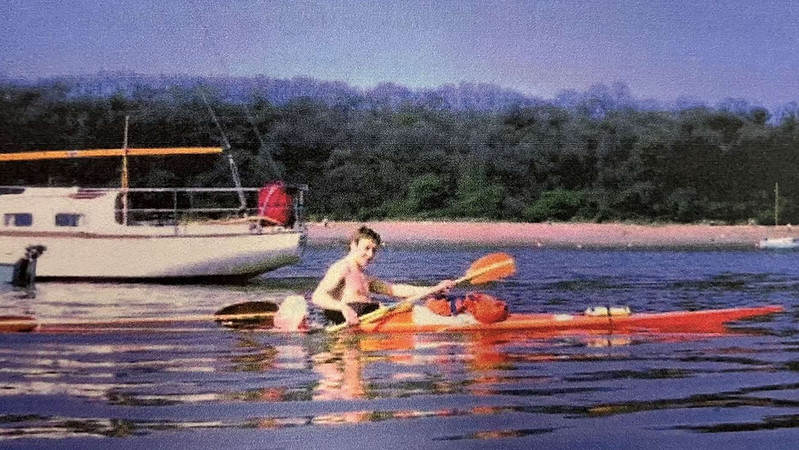
That was until his fateful crossing of the Solway Firth, between Scotland and England, which would involve a 16 mile open crossing. There was to be no drinking that night, unless you count a few unwanted mouthfuls of seawater. With a sense of foreboding and having made an aborted effort two days before, he set off on the crossing.
Geoff recalls how as the conditions worsened, his boat steadily filled up with water before suddenly his paddle broke and he capsized halfway across the Solway. "I got back in the boat but I only had half a paddle," he said. "I just found it such heavy work I got out and swam towards a buoy in the end.”
With the foresight to drag the kayak with him, he eventually managed to reach the buoy after a tough swim, but once he got there he realised that climbing up onto the buoy was impossible. However he eventually had the idea of looping the rope at the end of the kayak over the top of the buoy. "I pulled the boat half way up, so then I stepped on the boat and then on to the top, then I was kneeling on the top... I had to stay there all night.”
Geoff had got to the buoy at about 4pm but around 7pm, the painter snapped and he had to watch it float away with his supplies. "I thought do I get down and get to the canoe? But I thought 'no I'm dry now.’ I tied myself with the painter on to the top and stayed up there."
As the night set in, Geoff could see the lights from a near by town of Workington flickering five miles away as the bouy rocked below him. But with no sign of rescue he decided to swim for the town the next day.
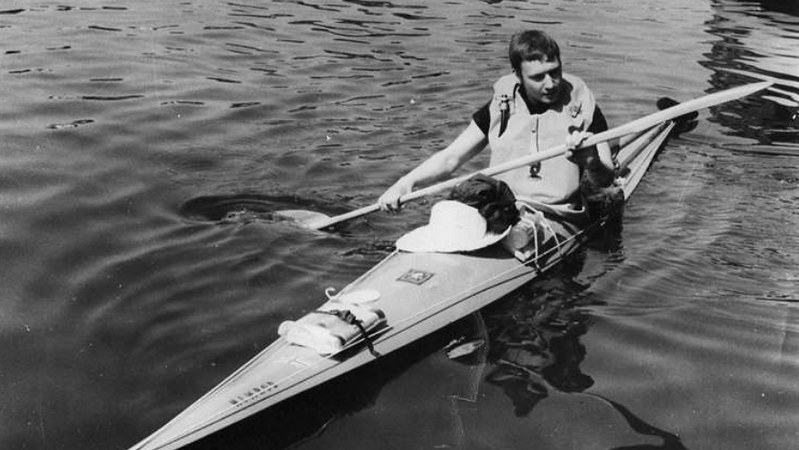
But when morning dawned he found himself surrounded by a thick mist. "When I set off in the morning I couldn't see Workington at all," he recalled. "It was the end of the tide going out that I started swimming because I knew that the tide would take me up into the Solway Firth rather than out to the Irish Sea so I then started swimming - back stroke, crawl, breastroke, I swam all sorts, it was a long way.”
"There was another buoy not that far away, probably about a mile, and I could see that in the water just every so often, so I headed for that. Once I was there I was closer to the land and I could actually see houses there, so I kept swimming and then a fishing boat came past.” Blowing on his whistle as hard as he could, Geoff tried to get the attention of the boat, but any sense of elation soon sank into the waves, as it carried on past him towards the coast.
"It cleared off and I then carried on swimming," he recalls. "But there were two couples in a little dinghy who had heard my whistling and then they came over, and the last mile and a half into Workington I got a lift with this little dinghy.”
Fortunately his rescuers also had a car and so rushed the, by now hypothermic, Geoff off to hospital. ”I sounded as if I was drunk but I wasn't" he explains but he soon got a warm bath and the care he needed.
By now Geoff was very motivated to complete his trip and once he recovered Geoff returned to Kent, borrowed a new boat, built to the same design, from his friend Ian Bourn and just over a week later he was back on the sea again paddling away from Workington. Meanwhile his original boat had washed up on shore, but having been smashed onto rocks by waves it needed repairs and it eventually ended up in a museum before Geoff got it back, 45 years later.
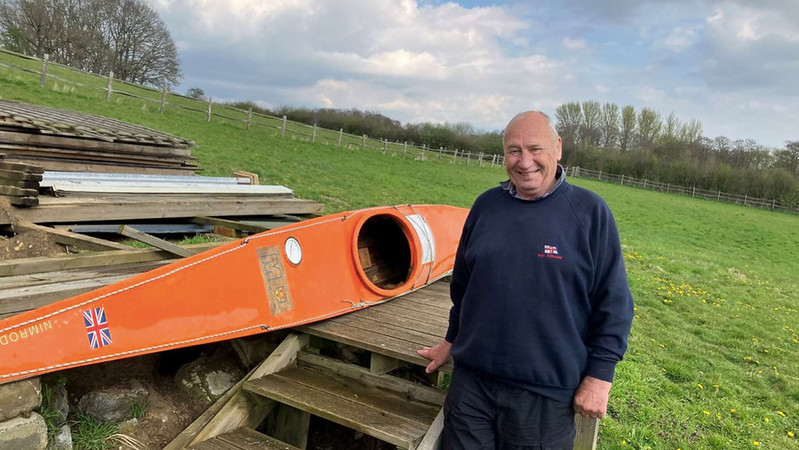
More adventures and near misses followed, including an encounter with some “20ft porpoises" who’s leaping from the water and slamming into the waves had him paddling for the shore. "Look and think again Geoff!" writes Bill Taylor, who suggests that what he actually encountered was probably some killer whales.
By now Geoff had survived storms, artillery fire, a near death experience in the Solway and an encounter with large marine mammals. But on the afternoon of November 4th he found himself back on the beach at Sheerness, where he had spent his first fearful night.
“I stepped out of [my boat and] dragged the kayak up onto the sand and walked onto the promenade. Opposite me was the funfair close to which I had made my first campsite, six long months ago. I had completed the first circumnavigation of England from Sheerness to Sheerness, by canoe.”
“No one saw me arrive, no one raised a cheer and the fishermen gave me nothing more than a scowl for upsetting their lines. Life around me was going on in the same old mundane way, but my personal achievement of doing what I had set out to do was coming home to me with every step I took to the phone box.”
“Dialling the coastguard for the last time I told the duty officer I was home, thanked them for their invaluable assistance over the last six months and apologised for any inconvenience I may have caused them.”
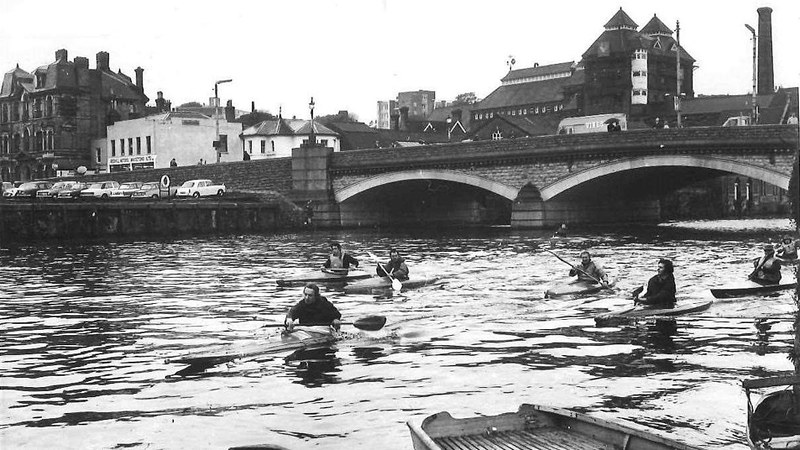
That night Geoff celebrated over a bottle of champaign with his ‘very relieved’ mother and some close friends. The next day while paddling to the official finish at Maidstone, Geoff was met by a couple of friends, Terry Nunn and Ian Bourne, who kayaked the last stretch with him. When they paused for a break Geoff’s log mentions: “it slowly became clear something special was brewing. Terry unhitched his spraydeck and produced a bottle of sherry, a tray, a table cloth, three glasses and a napkin…”
And so the celebrations continued, with a champagne breakfast when they reached Maidstone Canoe Club, before an official landing at the jetty near Maidstone Bridge where he was welcomed back by the Mayor of Maidstone, press photographers and a host of friends.
Many had called his expedition foolish, and maybe there were elements foolhardiness, but as Geoff quotes in the book “Thank God for fools! For men who dare to dream beyond the lean horizon of their days….”
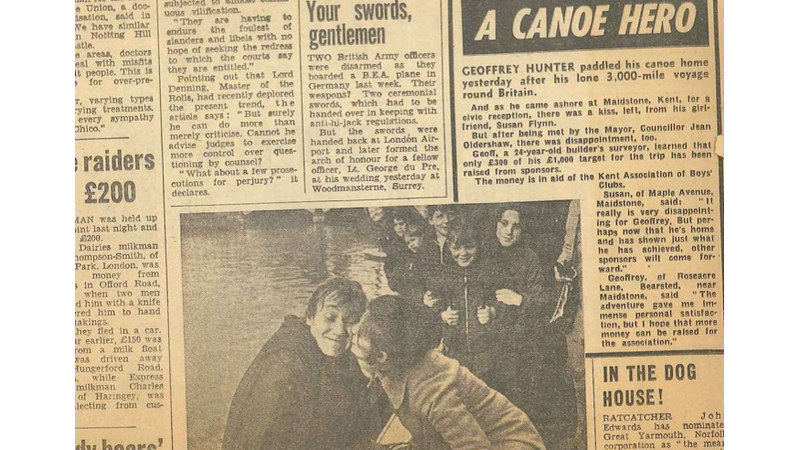
Buy The sea-Paddlers Tale from: Amazon - £10.69
You might also like:
- Video: East Greenland Sea Kayak Expedition
- Buyers Guide: Synthetic or natural base layers?
- An interview with: Nigel Dennis - Sea Kayaking Safely

By Philip Clegg
With over two decades of working in the sea kayaking industry, Phil can be found on a daily basis coaching for Sea Kayaking Anglesey. That's when he's not expeditioning, playing or putting kit to the test.


